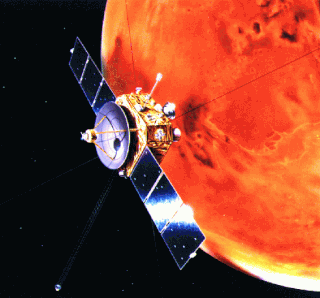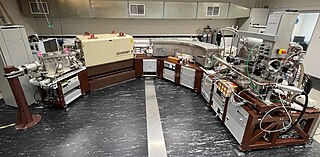
The atom probe was introduced at the 14th Field Emission Symposium in 1967 by Erwin Wilhelm Müller and J. A. Panitz. It combined a field ion microscope with a mass spectrometer having a single particle detection capability and, for the first time, an instrument could “... determine the nature of one single atom seen on a metal surface and selected from neighboring atoms at the discretion of the observer”.

Mass spectrometry (MS) is an analytical technique that is used to measure the mass-to-charge ratio of ions. The results are presented as a mass spectrum, a plot of intensity as a function of the mass-to-charge ratio. Mass spectrometry is used in many different fields and is applied to pure samples as well as complex mixtures.

An ion source is a device that creates atomic and molecular ions. Ion sources are used to form ions for mass spectrometers, optical emission spectrometers, particle accelerators, ion implanters and ion engines.
Plasma diagnostics are a pool of methods, instruments, and experimental techniques used to measure properties of a plasma, such as plasma components' density, distribution function over energy (temperature), their spatial profiles and dynamics, which enable to derive plasma parameters.

Nozomi was a Japanese Mars orbiter that failed to reach Mars due to electrical failure. It was constructed by the Institute of Space and Astronautical Science, University of Tokyo and launched on July 4, 1998, at 03:12 JST with an on-orbit dry mass of 258 kg and 282 kg of propellant. The Nozomi mission was terminated on December 31, 2003.

Secondary-ion mass spectrometry (SIMS) is a technique used to analyze the composition of solid surfaces and thin films by sputtering the surface of the specimen with a focused primary ion beam and collecting and analyzing ejected secondary ions. The mass/charge ratios of these secondary ions are measured with a mass spectrometer to determine the elemental, isotopic, or molecular composition of the surface to a depth of 1 to 2 nm. Due to the large variation in ionization probabilities among elements sputtered from different materials, comparison against well-calibrated standards is necessary to achieve accurate quantitative results. SIMS is the most sensitive surface analysis technique, with elemental detection limits ranging from parts per million to parts per billion.

X-ray spectroscopy is a general term for several spectroscopic techniques for characterization of materials by using x-ray radiation.
A microprobe is an instrument that applies a stable and well-focused beam of charged particles to a sample.

The sensitive high-resolution ion microprobe is a large-diameter, double-focusing secondary ion mass spectrometer (SIMS) sector instrument that was produced by Australian Scientific Instruments in Canberra, Australia and now has been taken over by Chinese company Dunyi Technology Development Co. (DTDC) in Beijing. Similar to the IMS 1270-1280-1300 large-geometry ion microprobes produced by CAMECA, Gennevilliers, France and like other SIMS instruments, the SHRIMP microprobe bombards a sample under vacuum with a beam of primary ions that sputters secondary ions that are focused, filtered, and measured according to their energy and mass.

An electron microprobe (EMP), also known as an electron probe microanalyzer (EPMA) or electron micro probe analyzer (EMPA), is an analytical tool used to non-destructively determine the chemical composition of small volumes of solid materials. It works similarly to a scanning electron microscope: the sample is bombarded with an electron beam, emitting x-rays at wavelengths characteristic to the elements being analyzed. This enables the abundances of elements present within small sample volumes to be determined, when a conventional accelerating voltage of 15-20 kV is used. The concentrations of elements from lithium to plutonium may be measured at levels as low as 100 parts per million (ppm), material dependent, although with care, levels below 10 ppm are possible. The ability to quantify lithium by EPMA became a reality in 2008.

Focused ion beam, also known as FIB, is a technique used particularly in the semiconductor industry, materials science and increasingly in the biological field for site-specific analysis, deposition, and ablation of materials. A FIB setup is a scientific instrument that resembles a scanning electron microscope (SEM). However, while the SEM uses a focused beam of electrons to image the sample in the chamber, a FIB setup uses a focused beam of ions instead. FIB can also be incorporated in a system with both electron and ion beam columns, allowing the same feature to be investigated using either of the beams. FIB should not be confused with using a beam of focused ions for direct write lithography. These are generally quite different systems where the material is modified by other mechanisms.

Isotope-ratio mass spectrometry (IRMS) is a specialization of mass spectrometry, in which mass spectrometric methods are used to measure the relative abundance of isotopes in a given sample.

JEOL, Ltd. is a major developer and manufacturer of electron microscopes and other scientific instruments, industrial equipment and medical equipment.
Static secondary-ion mass spectrometry, or static SIMS is a secondary ion mass spectrometry technique for chemical analysis including elemental composition and chemical structure of the uppermost atomic or molecular layer of a solid which may be a metal, semiconductor or plastic with insignificant disturbance to its composition and structure. It is one of the two principal modes of operation of SIMS, which is the mass spectrometry of ionized particles emitted by a solid surface upon bombardment by energetic primary particles.
Imago Scientific Instruments was a company founded in 1999 by Dr. Tom Kelly. At that time he was the Director of the Materials Science Center at the University of Wisconsin–Madison, but left his tenured position in 2001 to guide the company's growth.
AMETEK, Inc. is an American multinational conglomerate and global designer and manufacturer of electronic instruments and electromechanical devices with headquarters in the United States and over 220 sites worldwide.

NanoSIMS is an analytical instrument manufactured by CAMECA which operates on the principle of secondary ion mass spectrometry. The NanoSIMS is used to acquire nanoscale resolution measurements of the elemental and isotopic composition of a sample. The NanoSIMS is able to create nanoscale maps of elemental or isotopic distribution, parallel acquisition of up to seven masses, isotopic identification, high mass resolution, subparts-per-million sensitivity with spatial resolution down to 50 nm.

The Compagnie générale de la télégraphie sans fil was a French company founded in 1918 during a reorganization and expansion of the Société française radio-électrique (SFR), which became a subsidiary. The company developed technology for radio-telegraphy, radio program transmission, radar, television and other applications. It provided broadcasting and telegraphy services, and sold its equipment throughout the French colonial empire and in many other parts of the world. In 1968 CSF merged with the Thomson-Brandt to form Thomson-CSF.

Raimond Bernard René Castaing, also spelt as Raymond Castaing, was a French solid state physicist and inventor of various materials characterization methods. He was the founder of the French school of microanalysis and is referred to as the father of microanalysis.














